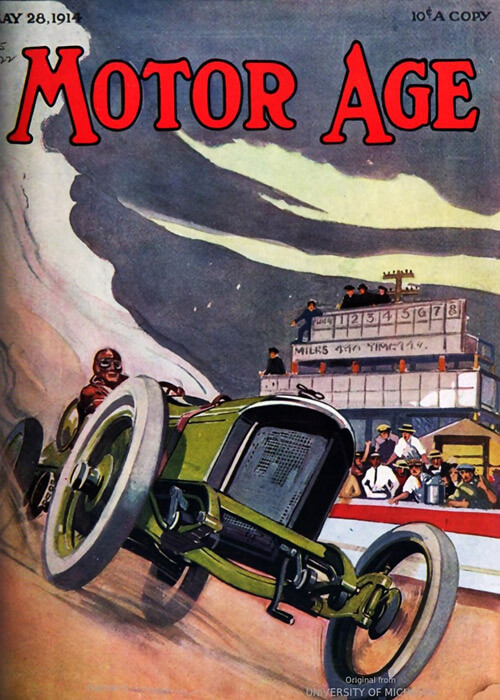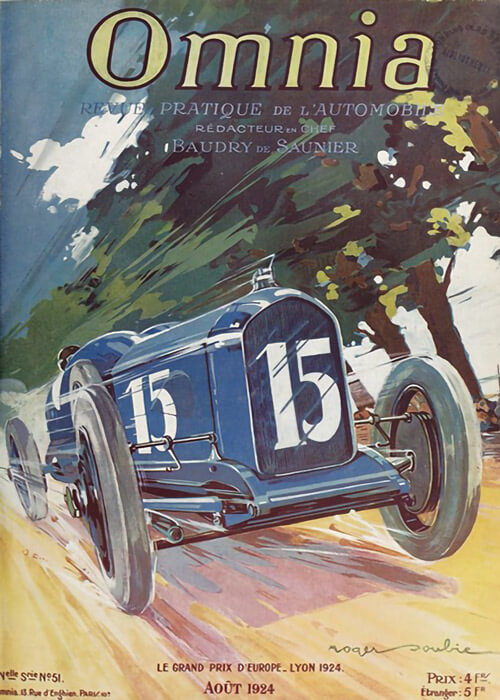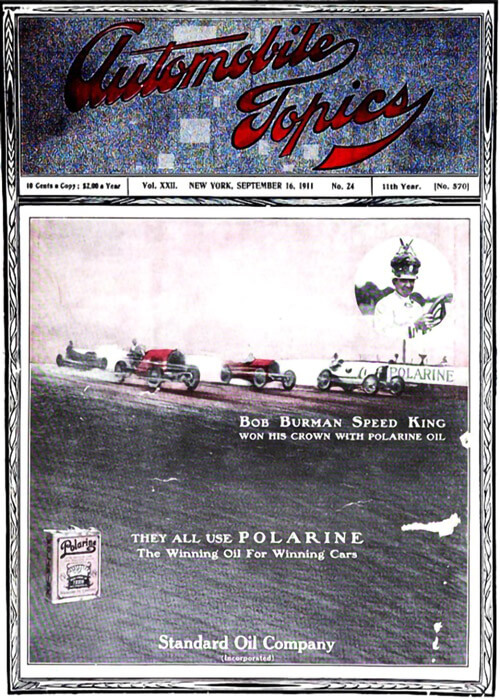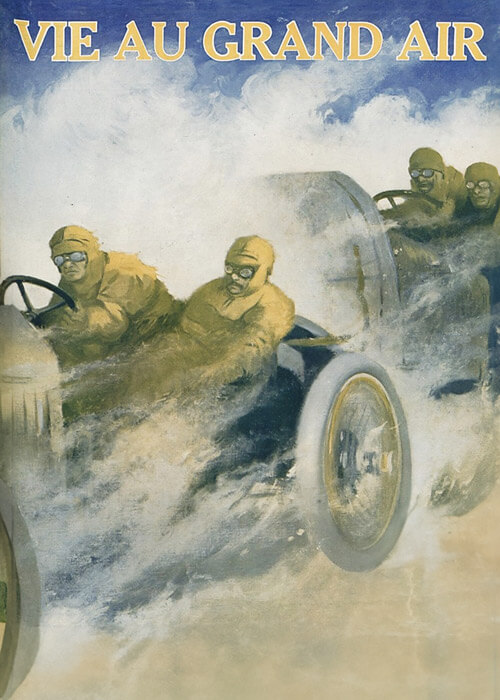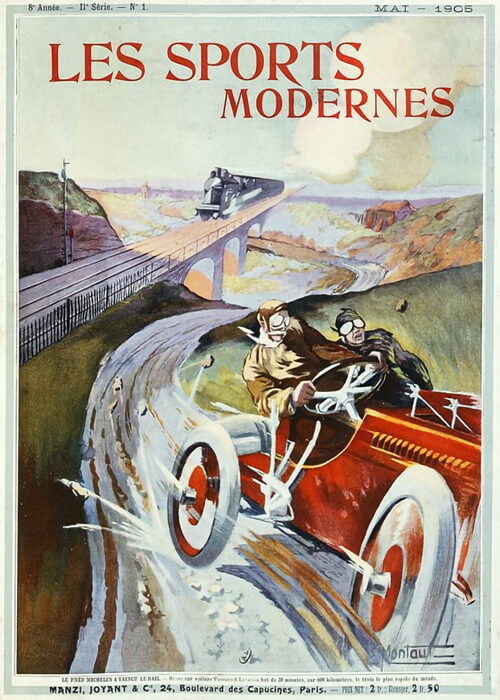Four interesting Editorial articles on the 1920 Indianapolis 500 race gathered here. Issues are: the new 183 cu. inch or 3-liter displacement rules and the small displacement eight-cylinder-in-line engines. Eight of the first ten cars that finished, were powered with this engine type. The coming of the small high-speed 8-in-line engines? The relatively large influence of car-and-engine designer on final racing results. And not to forget the high prize money, boosting the Indianapolis Race to an international interesting level. How speedway racing influences safety of car design.
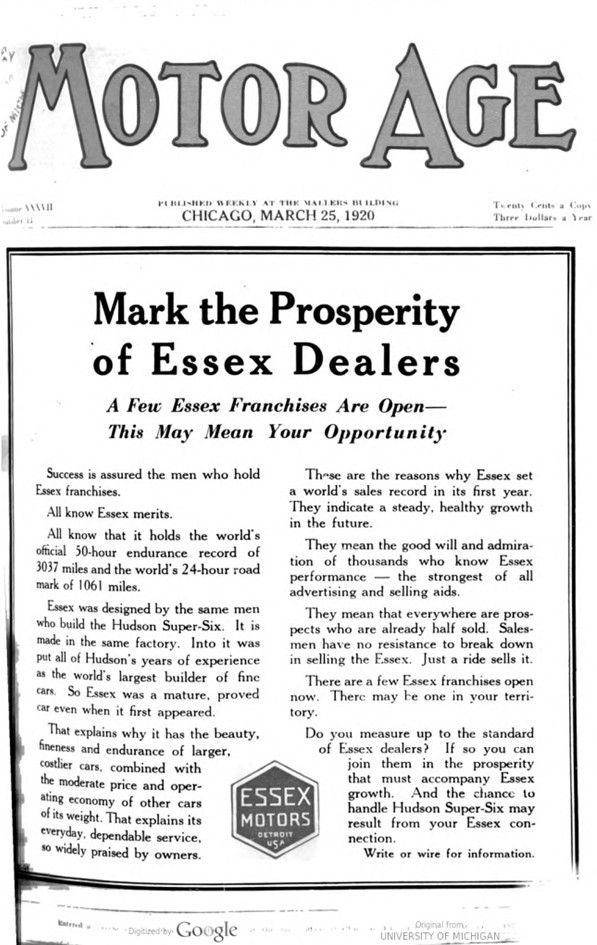
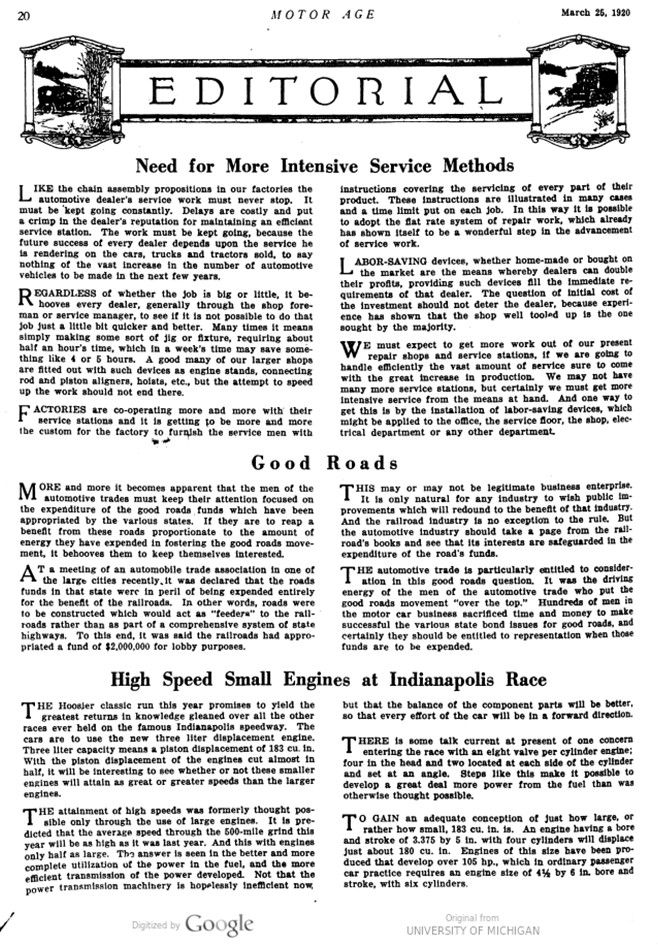
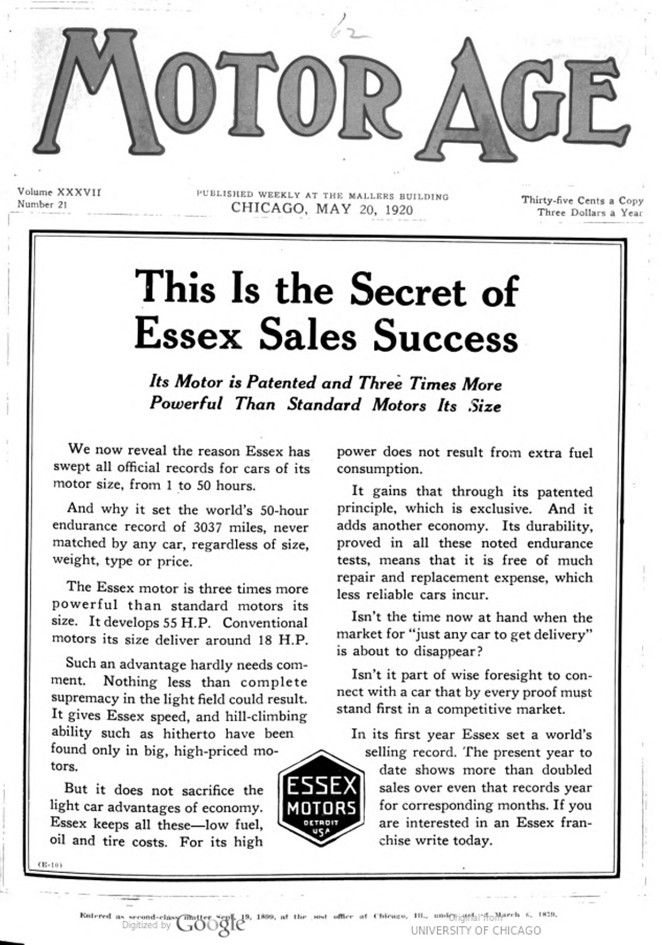
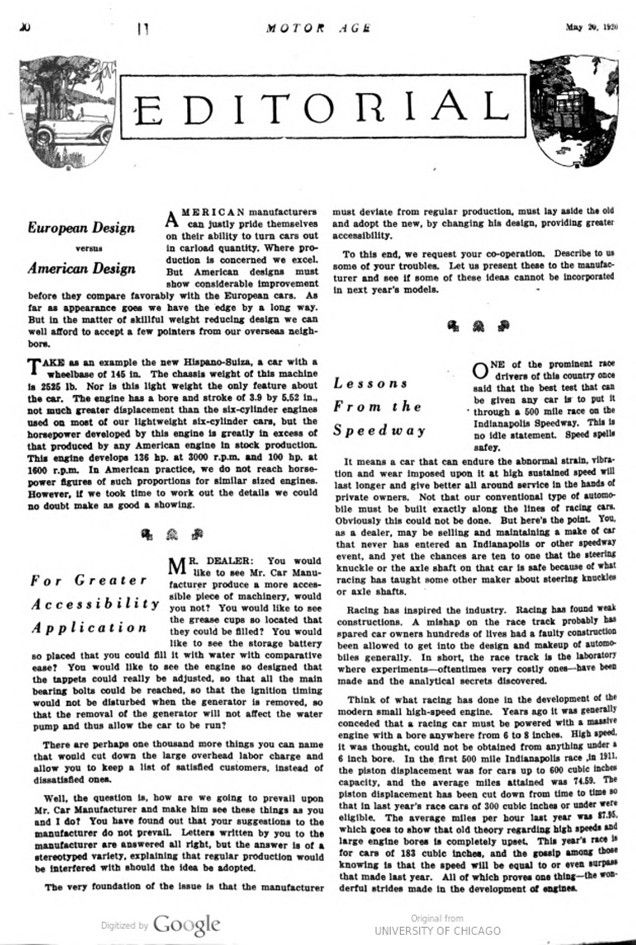
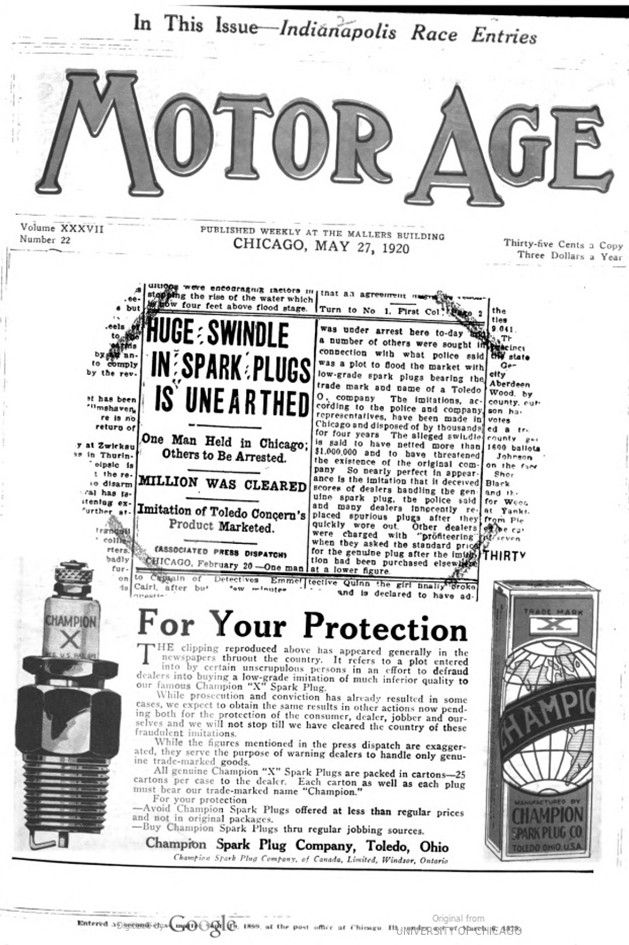
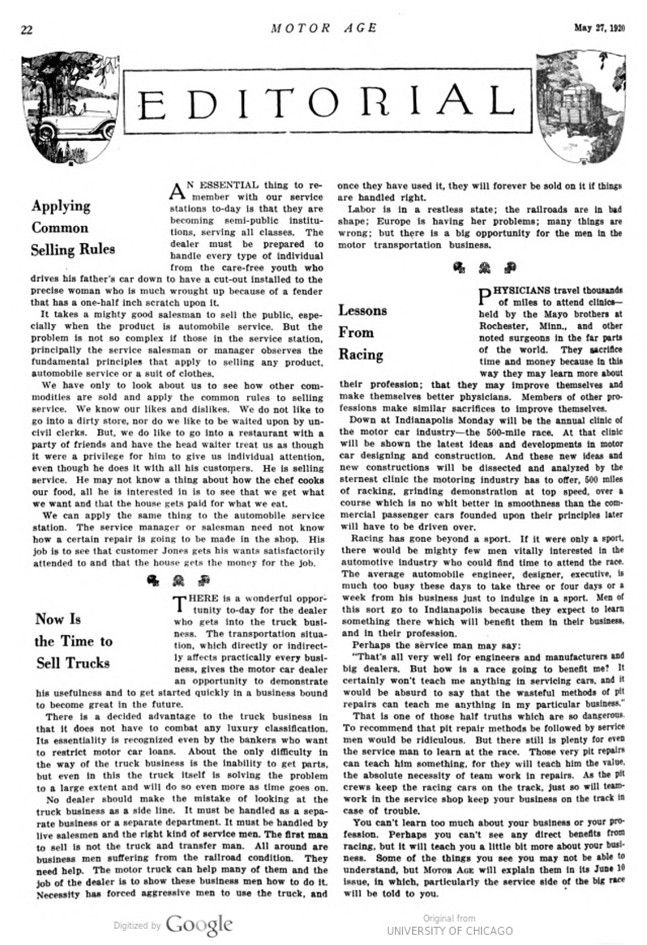
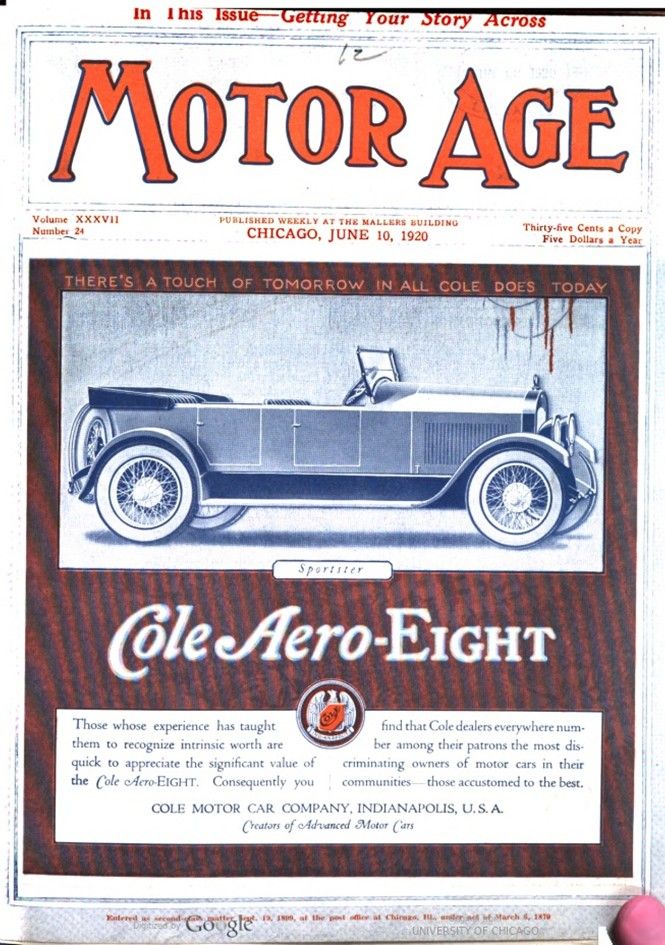

Text and jpegs by courtesy of hathitrust.org www.hathitrust.org, compiled by motorracinghistory.com
Motor Age, Vol. XXXVII, No. 13, March 25, 1920
EDITORIAL – High Speed Small Engines at Indianapolis Race
THE Hoosier classic run this year promises to yield the greatest returns in knowledge gleaned over all the other races ever held on the famous Indianapolis speedway. The cars are to use the new three-liter displacement engine. Three-liter capacity means a piston displacement of 183 cu. in. With the piston displacement of the engines cut almost in half, it will be interesting to see whether or not these smaller engines will attain as great or greater speeds than the larger engines.
THE attainment of high speeds was formerly thought possible only through the use of large engines. It is predicted that the average speed through the 500-mile grind this year will be as high as it was last year. And this with engines only half as large. The answer is seen in the better and more complete utilization of the power in the fuel, and the more efficient transmission of the power developed. Not that the power transmission machinery is hopelessly inefficient now, but that the balance of the component parts will be better, so that every effort of the car will be in a forward direction.
THERE is some talk current at present of one concern entering the race with an eight valve per cylinder engine; four in the head and two located at each side of the cylinder and set at an angle. Steps like this make it possible to develop a great deal more power from the fuel than was otherwise thought possible.
TO GAIN an adequate conception of just how large, or rather how small, 183 cu. in. is. An engine having a bore and stroke of 3.375 by 5 in. with four cylinders will displace just about 180 cu. in. Engines of this size have been produced that develop over 105 hp., which in ordinary passenger car practice requires an engine size of 4½ by 6 in. bore and stroke, with six cylinders.
Motor Age, Vol. XXXVII, No. 21, May 20, 1920
EDITORIAL – European Design versus American Design
AMERICAN manufacturers can justly pride themselves on their ability to turn cars out in carload quantity. Where production is concerned we excel. But American designs must show considerable improvement before they compare favorably with the European cars. As far as appearance goes we have the edge by a long way. But in the matter of skillful weight reducing design we can well afford to accept a few pointers from our overseas neighbors.
TAKE as an example the new Hispano-Suiza, a car with a wheelbase of 145 in. The chassis weight of this machine is 2525 lb. Nor is this lightweight the only feature about the car. The engine has a bore and stroke of 3.9 by 5.52 in., not much greater displacement than the six-cylinder engines used on most of our lightweight six-cylinder cars, but the horsepower developed by this engine is greatly in excess of that produced by any American engine in stock production. This engine develops 136 hp. at 3000 r.p.m. and 100 hp. at 1600 r.p.m. In American practice, we do not reach horse-power figures of such proportions for similar sized engines. However, if we took time to work out the details we could no doubt make as good a showing.
EDITORIAL – Lessons From the Speedway
ONE of the prominent race drivers of this country once said that the best test that can be given any car is to put it through a 500-mile race on the Indianapolis Speedway. This is no idle statement. Speed spells safety.
It means a car that can endure the abnormal strain, vibration and wear imposed upon it at high sustained speed will last longer and give better all around service in the hands of private owners. Not that our conventional type of automobile must be built exactly along the lines of racing cars. Obviously this could not be done. But here’s the point. You, as a dealer, may be selling and maintaining a make of car that never has entered an Indianapolis or other speedway event, and yet the chances are ten to one that the steering knuckle or the axle shaft on that car is safe because of what racing has taught some other maker about steering knuckles or axle shafts. Racing has inspired the industry.
Racing has found weak constructions. A mishap on the race track probably has spared car owners hundreds of lives had a faulty construction been allowed to get into the design and makeup of automobiles generally. In short, the race track is the laboratory where experiments-oftentimes very costly ones – have been made and the analytical secrets discovered.
Think of what racing has done in the development of the modern small high-speed engine. Years ago it was generally conceded that a racing car must be powered with a massive engine with a bore anywhere from 6 to 8 inches. High speed, it was thought, could not be obtained from anything under a 6-inch bore. In the first 500-mile Indianapolis race in 1911, the piston displacement was for cars up to 600 cubic inches capacity, and the average miles attained was 74.59. The piston displacement has been cut down from time to time so that in last year’s race cars of 300 cubic inches or under were eligible. The average miles per hour last year was 87.95, which goes to show that old theory regarding high speeds and large engine bores is completely upset. This year’s race is for cars of 183 cubic inches, and the gossip among those knowing is that the speed will be equal to or even surpass that made last year. All of which proves one thing – the wonderful strides made in the development of engines.
Motor Age, Vol. XXXVII, No. 22, May 27, 1920
EDITORIAL – Lessons From Racing
PHYSIC HYSICIANS travel thousands of miles to attend clinics – held by the Mayo brothers at Rochester, Minn., and other noted surgeons in the far parts of the world. They sacrifice time and money because in this way they may learn more about their profession; that they may improve themselves and make themselves better physicians. Members of other professions make similar sacrifices to improve themselves.
Down at Indianapolis Monday will be the annual clinic of the motor car industry-the 500-mile race. At that clinic will be shown the latest ideas and developments in motor car designing and construction. And these new ideas and new constructions will be dissected and analyzed by the sternest clinic the motoring industry has to offer, 500 miles of racking, grinding demonstration at top speed, over a course which is no whit better in smoothness than the commercial passenger cars founded upon their principles later will have to be driven over.
Racing has gone beyond a sport. If it were only a sport, there would be mighty few men vitally interested in the automotive industry who could find time to attend the race. The average automobile engineer, designer, executive, is much too busy these days to take three or four days or a week from his business just to indulge in a sport. Men of this sort go to Indianapolis because they expect to learn something there which will benefit them in their business, and in their profession.
Perhaps the service man may say:
„That’s all very well for engineers and manufacturers and big dealers. But how is a race going to benefit me? It certainly won’t teach me anything in servicing cars, and it would be absurd to say that the wasteful methods of pit repairs can teach me anything in my particular business.“
That is one of those half truths which are so dangerous. To recommend that pit repair methods be followed by service men would be ridiculous. But there still is plenty for even the service man to learn at the race. Those very pit repairs can teach him something, for they will teach him the value, the absolute necessity of team work in repairs. As the pit crews keep the racing cars on the track, just so will teamwork in the service shop keep your business on the track in case of trouble.
You can’t learn too much about your business or your profession. Perhaps you can’t see any direct benefits from racing, but it will teach you a little bit more about your business. Some of the things you see you may not be able to understand, but MOTOR AGE will explain them in its June 10 issue, in which, particularly the service side of the big race will be told to you.
Motor Age, Vol. XXXVII, No. 24, June 10, 1920
EDITORIAL – Reviewing the Indianapolis Race
CONSISTENCY was what undoubtedly won the race for Gaston Chevrolet and also the reason for the remarkable record which he made with his tires. He only made two stops. both of which were made to replenish his fuel tank. The first one was made at the 250-mile mark and took 1:35, the second one was made about five laps from the finish and took only forty-five seconds. His total time at the post was therefore only 2:20.
A year ago, it was freely predicted that there would be fours and sixes in the race, but few engineers would have said a little all-in-line vertical eight with 2 9/16 in. bore and 4 7/16 in. stroke would be considered a possibility in this year’s race. However, it was this type of engine which propelled the fastest car, the Ballot driven by Ralph DePalma. at 100 miles per hour for a lap during the elimination trials. Although defeated by a four-cylinder Monroe the eight-cylinder cars took the palm when it came to consistency. Eight of the ten cars which finished the 500 miles and won positions in the race had eight cylinder vertical all-in-a-line engines. The fact that two engineers, Ernest Henri, the designer of the former Peugeots and the present Ballot as well as Fred S. Duesenberg should have adopted the eight-cylinder engine of this type as the one most desired for a 500-mile race is significant.
It is also significant that with the change of engineer Henri from the Peugeot camp to the Ballot camp, victory left one altogether, and was almost in the hands of the other, when a magneto put Ralph DePalma out of the running. Just as in the past, the winning of race is done as much on the engineer’s drafting board, months before the race, as it is by the skill of the driver and the workmanship of the mechanics, before and during the race.
The 500-mile races on the Indianapolis Motor Speedway have put Indianapolis on the world map just as the Derby has fixed horse racing as the great sport of England. The fact that nearly $100,000 was given away at this year’s race only emphasizes the importance of this as a sporting event. It is intimated that more than $200,000 will be given away next year. Indianapolis will probably make their lap prize $200 per lap instead of $100. Other automotive producing cities have intimated that they would like to put up a lap prize, and it is quite possible that the total lap prizes will be around $500, and there is a possibility that the Speedway purse may be increased to $100,000.
